One of the first things your chiropractor will do during an initial exam is look at your posture. Posture is much more than the ability to stand up straight; the physical body works together as a system, meaning a seemingly distant site, such as the feet, can potentially cause headaches. We can’t avoid certain positions entirely as we go about our day, and holding any posture for too long is going to create compensation and imbalances. The best ways to help manage your posture at home is to make sure your work setup is ergonomic, to change positions often, and to get up and stretch. The following article outlines 13 stretches to help improve your posture and lower your pain.
Generally speaking, your spine is like Jenga blocks. When stacked directly on top of each other it is easy to stay upright, but the more they become off-center, the harder and harder it becomes. One expert, Kapandji, stated in his book that for every inch your neck moves forward in what is termed “forward head posture,” it can add an additional 10 pounds of weight to your neck.
Your posture affects how you breathe and maintain balance, too! One study found that those with forward head posture had a decreased respiratory function due to a change in thoracic mobility, while another found that it decreased standing balance control.
If an image of you looking down at your phone waiting for a train or your morning coffee immediately comes up, don’t worry! Posture can be easily corrected over time with the right habit changes, movements, and exercises that I’ll share with you here. Here’s how you can improve your posture with these 13 simple exercises:
The first exercise: Keep moving!
There is no such thing as bad posture—the only bad posture is the one you’ve been in for too long.
The more we can create variability in movement, the happier our bodies will be! This is as simple as getting up from your desk every 20 to 30 minutes. If timing is difficult for you, maybe decide that every time you answer a specific email or call, you’re going to get up and move around.
Movements can be specific exercises like the ones below but can also be as simple as walking to grab water or going to the bathroom. The key here is the more we move, the better our bodies will feel in the long run. Advertisement
Simple exercises you can do sitting down.
These movements are meant to target moving the spine in all six directions—flexion, extension, rotation, and sidebending, as well as stretches for the hips and arms.
These are best performed breath-to-movement. In addition to posture, we often are only using our upper chest to breathe and are not reaching maximal capacity. This will help not only move your spine but also reach a more relaxed state by repeating for 10 to 15 cycles of breath:
1. Seated Cat/Cow
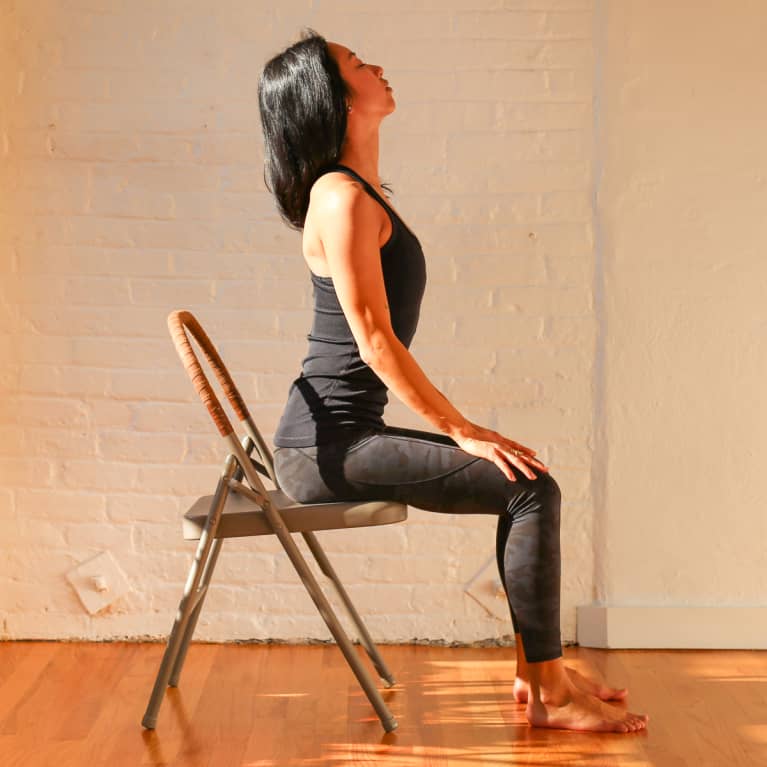
How to: Start with your hands on your knees as you sit in your chair. On your inhale, lift the heart up and forward. On your exhale, tuck your chin to your chest and round the spine.
2. Seated Rotation

How to: On your inhale, reach hands up to the sky. On your exhale, bring one hand to the opposite knee and the other to the back of a chair, or simply reach behind you. Repeat on the other side.
3. Seated Side Bend

How to: On your inhale, reach your hands up to the sky. On your exhale, side bend to one side, reaching the top hand up and over. Repeat to the other side.
4. Seated Figure 4

How to: Try to keep both sitz bones rooted into the chair while keeping as long of a spine as possible. The elongation of your spine matters more than trying to get lower down.
5. Seated HS Stretch
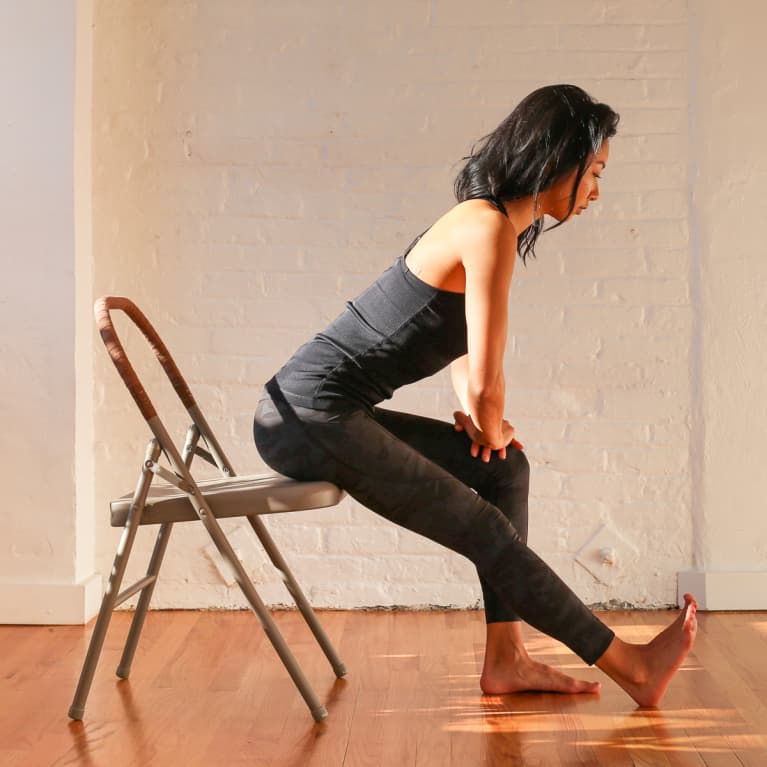
How to: Try to keep both sitz bones rooted into the chair while keeping as long of a spine as possible. The elongation of your spine matters more than trying to get lower down.
6. Prayer Stretch

How to: Keeping a slight engagement of the low belly to protect the low back; keep elbows on a surface in front of you; flip palms up to the sky and reach for your upper back.
Simple exercises to wake up the body.
These movements are meant to bring general energy and blood flow back into the body when taking a movement break. Performing 12 to 15 reps of each 2 to 3 times is short and sweet but very effective!
1. Squat
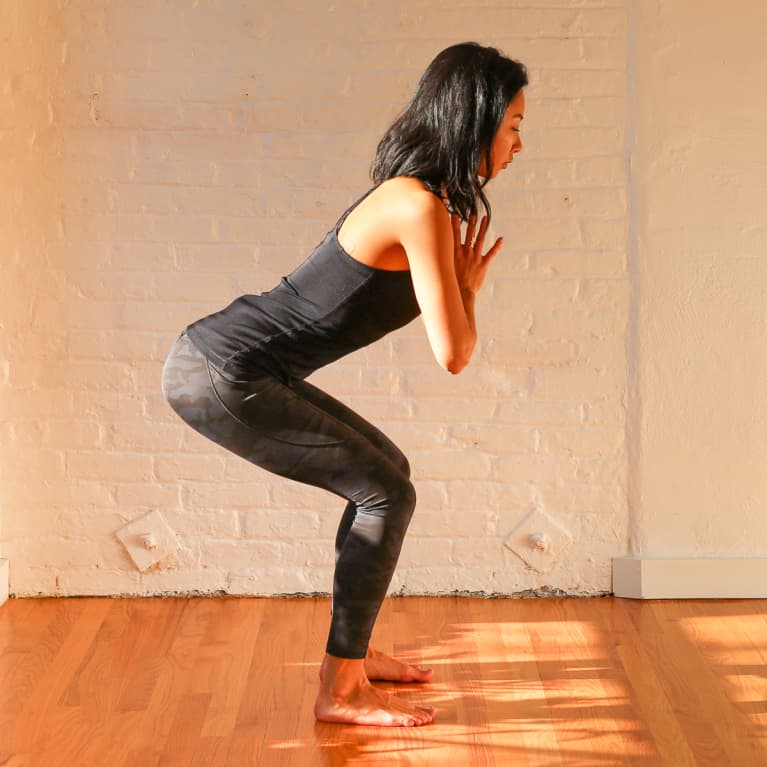
How to: Stand with your feet hip-width apart or slightly wider with toes turned slightly out. Keep the knees behind the toes as you bend back and think of your glutes reaching back, trying to sit in a chair behind you. Push through your heels as you return to stand.
2. Hip Circles
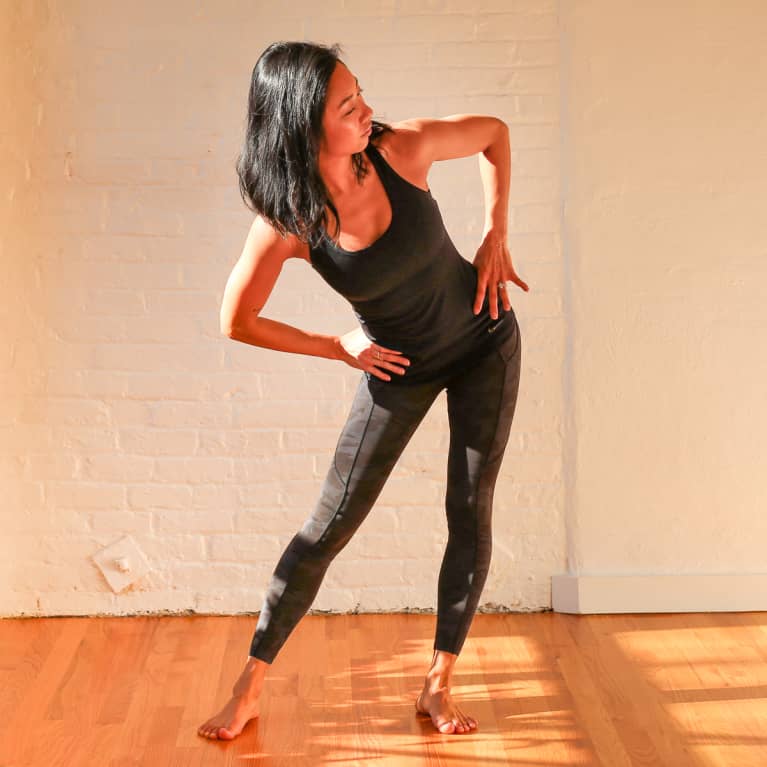
How to: Hands on your hips, bring your feet wider than hip width and circle your hips clockwise and counterclockwise. The bigger the circle, the better!
3. Reach Up to Cactus Arms

How to: On your inhale, reach your hands up to the sky. On your exhale, bend your elbows into a goalpost position gently lifting the heart up for a mini backbend to open the chest.
Easy restorative moves to decrease muscle tension.
These positions are best performed at the end of the day to relieve any tension built up over the day. I sometimes stay in these for 15 to 20 minutes each while listening to a podcast or relaxing before sleep:
1. Supported Fish
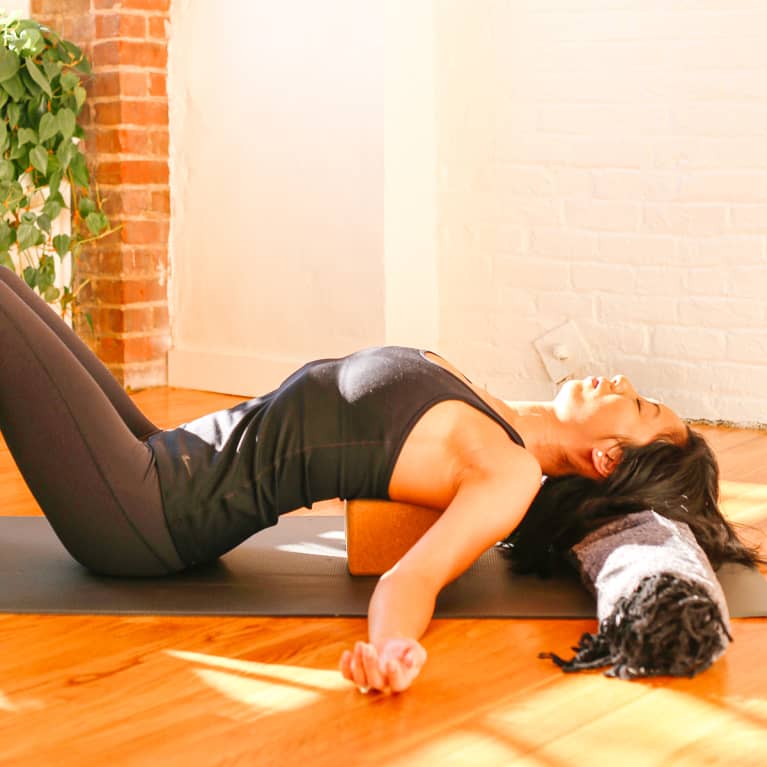
How to: You can use blocks or rolled-up pillows or blankets. Place one so that the bottom is at the base of your shoulder blades, no lower, and the other is supporting the head. You can start with them both at the same height and adjust based on how much you want your chest to open. Arms should be open wide in between the two supports. You can bend your knees to take out some pressure in the back.
2. Supta Baddha Konasana

How to: Press the soles of your feet together to make a diamond shape. You can use blocks, rolled-up pillows, or blankets as support to bring the ground closer underneath your knees.
3. Supine Twist

How to: You can use blocks, rolled-up pillows, or blankets as support between the knees and underneath the arm. Allow the knees to fall to one side, bringing them closer to the chest. Goalpost the arms and allow them to fall to the ground.
Our bodies were meant to move constantly. The more we change up our positions throughout the day, the less likely it is for us to become stagnant—physically, mentally, and energetically. Give the body a little wake and shake. Your posture and your soul will thank you later!
If you have questions about which stretches are right for you, email us at info@evolvevancouver.ca to book a consultation with one of our chiropractors.